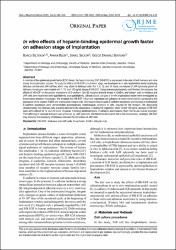| dc.contributor.author | Biltekin, Burcu | |
| dc.contributor.author | Bilir, Ayhan | |
| dc.contributor.author | Seçkin, İsmail | |
| dc.contributor.author | Şentürk, Gözde Erkanlı | |
| dc.date.accessioned | 2024-04-16T14:31:23Z | |
| dc.date.available | 2024-04-16T14:31:23Z | |
| dc.date.issued | 2023 | en_US |
| dc.identifier.citation | Biltekin, B., Bilir, A., Seçkin, İ., & Şentürk, G. E. (2023). In vitro effects of heparin-binding epidermal growth factor on adhesion stage of implantation. ROMANIAN JOURNAL OF MORPHOLOGY AND EMBRYOLOGY, 64(4), 493-500. https://doi.org/10.47162/RJME.64.4.05 | en_US |
| dc.identifier.issn | 2066-8279 | |
| dc.identifier.uri | https://hdl.handle.net/20.500.12900/347 | |
| dc.description.abstract | A member of the epidermal growth factor (EGF) family, the heparin-binding EGF (HB-EGF) is expressed in the uteri of both humans and mice during the implantation process. To study the effects of HB-EGF on adhesion stage, we developed an in vitro implantation model employing Ishikawa cell line and JAR cell line, which may attach to Ishikawa cells. For 1, 6, 12, and 24 hours, co-cultures of JAR spheroids grown on Ishikawa monolayers were treated with 1, 10, and 100 ng/mL doses of HB-EGF. Using immunocytochemistry and Western blot analysis, the effects of HB-EGF on the protein expressions of E-cadherin, Erb-B2 receptor tyrosine kinase 4 (ErbB4), and integrin alpha nu beta(3) in Ishikawa and JAR cells were examined semi-quantitatively and quantitatively. Ultrastructural changes of in vitro implantation model were investigated by transmission electron microscopy. We revealed that HB-EGF influenced trophoblast cell adhesion to endometrial cells by upregulating the expression of the proteins ErbB4 and trophoblastic integrin alpha nu beta(3). Decrease in trophoblastic E-cadherin expression and increase in endometrial E-cadherin expression were demonstrated accompanying morphological variations in cells required for the invasion. We discovered ultrastructurally that Ishikawa cells acquired uterodome-like appearance, including the organelles, when 10 and 100 ng/mL dosages of HB-EGF were administered for 12 and 24 hours. However, following additional hours of adhesion and invasion, their intercellular spaces enlarged. The trafficking of vesicular transport was enhanced by JAR spheroids. We therefore discovered that in this implantation paradigm, HB-EGF may enhance the receptivity of Ishikawa cells and the adherence of JAR cells. | en_US |
| dc.language.iso | eng | en_US |
| dc.publisher | EDITURA ACAD ROMANE | en_US |
| dc.relation.isversionof | 10.47162/RJME.64.4.05 | en_US |
| dc.rights | info:eu-repo/semantics/openAccess | en_US |
| dc.subject | Ishikawa ve JAR hücreleri | en_US |
| dc.subject | Ishikawa and JAR cells | en_US |
| dc.subject | HB-EGF | en_US |
| dc.subject | ErbB4 | en_US |
| dc.title | In vitro effects of heparin-binding epidermal growth factor on adhesion stage of implantation | en_US |
| dc.type | article | en_US |
| dc.department | İstanbul Atlas Üniversitesi, Tıp Fakültesi, Temel Tıp Bilimleri Bölümü | en_US |
| dc.authorid | https://orcid.org/0000-0002-8435-6797 | en_US |
| dc.contributor.institutionauthor | Biltekin, Burcu | |
| dc.contributor.institutionauthor | Bilir, Ayhan | |
| dc.identifier.volume | 64 | en_US |
| dc.identifier.issue | 4 | en_US |
| dc.identifier.startpage | 493 | en_US |
| dc.identifier.endpage | 500 | en_US |
| dc.relation.journal | ROMANIAN JOURNAL OF MORPHOLOGY AND EMBRYOLOGY | en_US |
| dc.relation.publicationcategory | Makale - Uluslararası Hakemli Dergi - Kurum Öğretim Elemanı | en_US |

















